Figure shows two identical prisms P and Q placed with their faces parallel to each other. A light ray AB of yellow colour is incident at the face of the prism P. Complete the diagram to show the path of the ray till it emerges out of the prism Q.
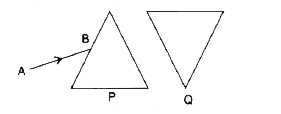
The completed diagram is shown in figure in which the ray CD emeging out of the prism Q is parallel to the ray AB incident on the prism P.
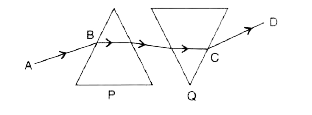 .
.
Topper's Solved these Questions
- BOOK - ICSECHAPTER - REFRACTION OF LIGHT AT PLANE SURFACESEXERCISE - EXERCISE-4(A)31videos
REFRACTION OF LIGHT AT PLANE SURFACES
- BOOK - ICSECHAPTER - REFRACTION OF LIGHT AT PLANE SURFACESEXERCISE - EXERCISE-4(A) MULTIPLE CHOICE TYPE3videos
REFRACTION OF LIGHT AT PLANE SURFACES
- BOOK - ICSECHAPTER - REFRACTION OF LIGHTEXERCISE - DIAGRAM BASED MCQ:5videos
REFRACTION OF LIGHT
- BOOK - ICSECHAPTER - REFRACTION THROUGH A LENS EXERCISE - EXERCISE-5(D) (MULTIPLE CHOICE TYPE)2videos
REFRACTION THROUGH A LENS
Similar Questions
Figure below shows two identical prisms A and B placed with their faces parallel to each other. A ray of light of single colour PQ is incident at the face of the prism A. complete the diagram to show the path of the ray till it emerges out of the prism B.
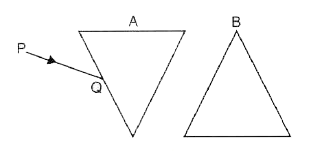 View Solution
View SolutionA ray of light falls normally on a rectangular glass slab.
Draw a ray diagram showing the path of the ray till it emerges out of the slab.View Solution(a) Figure shows two isosceles right angled prisms A and B and the light rays incident on the prism A. complete the diagram to show the rays emerging out of the prism B.
(b) State the principle used for completing the ray diagram in part (a) above.
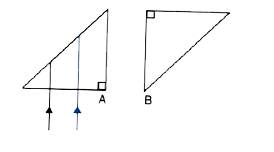 View Solution
View SolutionFigure below shows a light ray of green colour incident on the prisms A,B and C. in each case, draw the path of the ray of light as it enters and emergest out of the prism. Mark the angle wherever necessary.
 View Solution
View SolutionA ray of light PQ is incident normally on the hypotenuse of a right angled prism ABC as shown in the diagram given below:
Copy the diagram and complete the path of the ray PQ till it emerges from the prism.View SolutionComplete the path of the monochromatic light ray AB incident on the surface PQ of the equilateral glass prism PQR till it emerges out of the prism due to refraction.
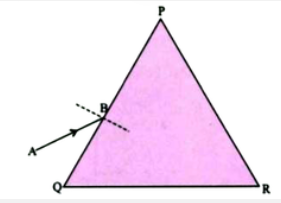 View Solution
View SolutionA ray of light falls on a normally on a refracting face of a prism. Find the angle of prism if the ray just fails to emerge from the prism (μ=3/2).
View SolutionThe diagram alongside shows a beam of light (red + blue) incident normally on an equilateral triangular prism. If the critical angle for the material of prüsm is 60∘ for the light of red colour, complete the diagram showing the path of light of each colour emerging out of the prism. Mark in the diagram the angles wherever necessary.
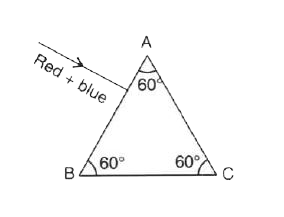 View Solution
View SolutionA light ray is normally incident onone face of equilateral glass prism of refractive index √2. The deviation of light ray is
View SolutionFigure alongside shows an equilateral prism ABC and the ray QR emerging out from the prism after suffering minimum deviation. Complete the diagram to show the refracted ray PQ inside the prism and the incident ray OP on the prism. State in words how have you completed the diagram to show the refracted ray PQ inside the prism and the incident ray OP on the prism. state in words how have you completed the diagram.
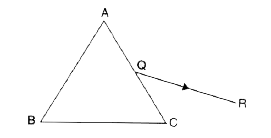 View Solution
View Solution

